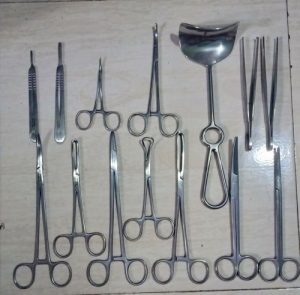Sometimes it is necessary during childbirth to help the baby to come out with forceps. What are they for? How is a forceps birth? The essentials to know about the use of forceps.
Definition of forceps
The forceps is a metal extraction instrument in the form of a forceps that allows you to grip the head of a fetus to facilitate its expulsion. It consists of two branches that are introduced separately and articulated together after their installation. This allows the fetus to be guided through the genital tract using the same mechanism as if it were pushed by the mother’s expelling efforts. It is an instrument of traction.
There are different types of forceps, with crossed branches or converging branches.
When to use forceps
An instrumental extraction with forceps is indicated when it is necessary to accelerate the delivery or facilitate the birth.
Main indications for applying forceps:
- Expulsion phase which lasts more than 30 minutes
- Fetal heart rhythm abnormalities
- Stop progression of the fetal head engaged in the pelvis
- Help with expulsion when the mother is tired or has a uterine scar
- Expulsion assistance in the event of maternal illness (eclampsia, pre-eclampsia, heart disease,
- Respiratory failure, etc.), which represents a contraindication to expulsion efforts
How does a forceps delivery work?
To avoid tearing the perineum, the use of forceps is almost always accompanied by an episiotomy. If the mother is not on an epidural, local anesthesia may be performed. The branches of the forceps are placed on either side of the fetal head. The doctor performs regular and moderate pulls on the forceps during uterine contractions to help the baby in his descent.
This instrument may leave some marks on the baby’s temples, cheeks or skull, but they are not serious and usually disappear in 2 or 3 days.
The consequences of forceps
The use of forceps has consequences, to varying degrees, for mothers and babies. Most often, the consequences are benign!
Rest assured, when used wisely and gently, forceps do not present any particular danger to the mother or the baby.
Consequence of forceps for the baby
This instrument may leave some marks on the baby’s temples, cheeks or skull, but they are not serious and usually disappear in 2 or 3 days.
The baby may present lesions due to the use of forceps: hematomas of the scalp or face, bone lesions of the skull, paralysis of the cranial nerves…
Consequence of forceps for the mother
Here again, the introduction of forceps often has consequences, most often benign.
The immediate consequences of the use of Asch septum forceps 23 cm for the mother can be minimal (superficial vaginal tear) but also, more rarely, severe: tears of the perineum, vagina, urinary and digestive lesions (wounds in the bladder, urethra, and sphincters).
The use of forceps can also cause secondary complications: retention of urine requiring probing, blood in the urine, rectovaginal fistula, dyspnareunia (pain during sexual intercourse) … Late but very rare complications are also possible. : stress urinary incontinence, anal incontinence.
Spatulas suction cups or forceps… what are the differences?
Several instruments exist to get the baby out more quickly: forceps, suction cup or spatula. The instrument is chosen according to the situation and the experience of the doctor who uses them. The forceps is the most widely used instrument.
The suction cup is a flexible material instrument that is placed on the top of the baby’s skull to guide him as he descends through the pelvis. The suction cup is pulled gently during a contraction to flex the baby’s head. It is a traction instrument that complements the mother’s expulsive efforts by improving the flexion of the baby’s head and inducing the rotation of the latter in the mother’s pelvis.
Spatulas look like forceps. It is an instrument with two spoons, but these are not connected unlike the forceps. They extend the hands of the midwife. Spatulas are used to guide the baby’s head towards the exit.
For more details, please visit: jimymedical.co.uk
